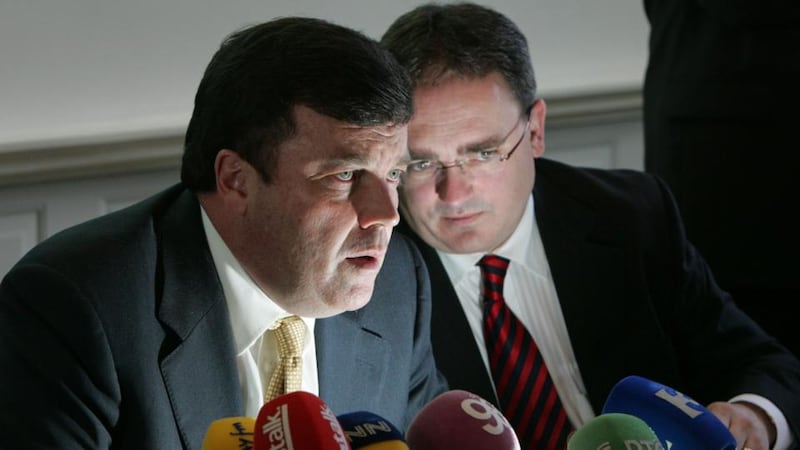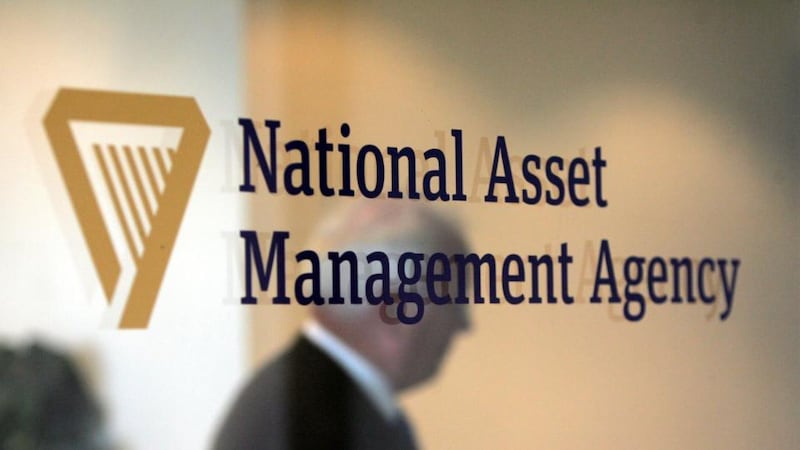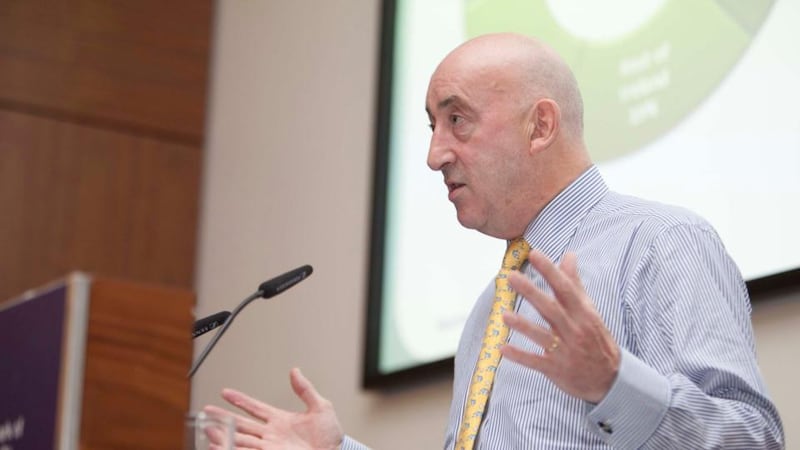The National Asset Management Agency was created in 2009 to help contain the spiralling fallout from Ireland's property crisis. It was to be the State's "bad bank", an impartial agency that could revalue depressed assets and sell them on to the highest bidders. Eight years later the Irish economy is once again beginning to buzz, and Nama has presided over the transfer of more than €70 billion in assets. It is regularly touted, by its founders in Leinster House and elsewhere, as a key component in Ireland's recovery. In his new book, Nama Land, the investigative journalist Frank Connolly unravels what happened
Brendan McDonagh sat in a corridor in Government Buildings, on Merrion Street in Dublin, where Taoiseach Brian Cowen, Minister for Finance Brian Lenihan, other cabinet members, senior civil servants, bank executives, accountants, solicitors and other advisers convened on the night of the infamous “bank guarantee” of September 29th, 2008.
“Infamous” because the outcome of the crisis meetings, which followed the disclosure that Ireland’s main banks were facing insolvency, was the decision to protect depositors for up to €100,000 each and, controversially, all lenders, including unsecured bondholders, so exposing the State to multibillion-euro debts and forcing it into the arms of an bailout programme agreed with the troika of the European Commission, European Central Bank and International Monetary Fund.
McDonagh, a senior executive at the National Treasury Management Agency, which is charged with handling the State's finances, including the national debt, was not invited to the discussions that resulted in the guarantee, despite his vigil into the early hours of September 30th, 2008.
In the weeks and months that followed he was, however, central to the construction of the “bad bank” established to transfer the distressed borrowings of the financial institutions in order to save what remained of a functioning banking sector.
A failure of State regulation, combined with banking's greed-fuelled bonus culture, had seen Ireland suffer the largest financial collapse of any developed country since the 1930s
The objective, in particular, was to remove the toxic debt incurred by the main lenders – Bank of Ireland, Allied Irish Banks, Anglo Irish Bank, Irish Nationwide Building Society, and Permanent TSB – which were hugely exposed to a property market that had now collapsed.
The other core objective was to restore liquidity in the banking system, so it could resume its crucial function of lending to commercial and other borrowers as a key motor of the economy.
Most of the developers, builders and other investors who had borrowed freely and frivolously during the boom years were now broke. The value of their remaining assets was only a fraction of the monies that they had borrowed, and that had been lent so recklessly over the previous decade and more.

Debt mountain
A complete failure of State regulation, combined with an arrogant and greed-fuelled bonus culture in the banking sector, had brought down the economy as Ireland suffered the largest financial collapse of any developed country since the 1930s.
The insistence by the European Commission and ECB that the debts owed to other reckless lenders in German, French, British and US financial institutions, including unsecured creditors, must be paid in full added billions to the debt mountain. It also contributed to the problems faced by the crisis-ridden Fianna Fáil-led coalition with the Green Party as another turbulent new year approached at the end of 2008.
The minister for finance, Brian Lenihan, turned to the NTMA for advice on how a bad bank could be formed and consulted the economist Dr Peter Bacon, who prepared a report and provided a detailed explanation of the role of the National Asset Management Agency when its birth was announced, in early April 2009.
At a press briefing at the NTMA offices in Dublin on April 8th, Lenihan unveiled the plan to transfer up to €90 billion of property- and land-related loans, including unimpaired loans, from the banks to Nama.Insisting that the initiative was a bailout not of the banks but of the economy, Lenihan said that it was about “ensuring that business and individuals who cannot access credit can access credit”.
Dr Bacon, who had advised the government on land and housing policy during the boom years, added that the creation of the bad-bank agency would involve bank shareholders taking considerable pain. “We are cleaning the balance sheets of the organisations to ensure the institutions can resume their proper role as motors of credit in the Irish economy,” he stressed.
Inevitably, the announcement of the plan attracted criticism and scepticism at home and abroad, with concerns expressed about the lack of detailed information on the extent of the bad loans, including from some of the developers whose debts were to be transferred to the new agency and for whom there was little public sympathy.

No idea
There was some surprise, however, when the chief executive of the NTMA, Dr Michael Somers, told the Committee of Public Accounts just weeks later that he had no idea how Nama would operate. He was concerned at the haste with which the project was conceived, did not believe that the NTMA was the appropriate body to oversee the operation and insisted that it did not have sufficient staff to operate the new agency.
Somers also disputed the extent of the State’s exposure. He argued that at the end of 2008 the State’s total gross debt was about €70 billion and that it had about €20 billion in cash. The scale of his frustration about the way Nama was established emerged when it was revealed that Somers had sought to retire, with immediate effect, two months earlier.
After 48 years in public service, including 18 as chief executive of the NTMA, Somers said that he was “beyond normal retirement age”. In a letter to the minister for finance he wrote that his contract had been due to expire in December 2007 and had been extended by three years, but he was prepared to work “in a non-pensionable capacity” until a successor was found.
His letter of March 11th, 2009, came just a week after Lenihan had written to Somers asking him whether the NTMA could “take steps to develop contingency plans for the provision of liquidity to the Irish banking system in the event of further liquidity pressures within that system”.
Somers’s expression of scepticism was an inauspicious start for the agency – but one that did not deter its architects from preparing the legislation, structures and recruitment to take on the mammoth task of rescuing the banks and restoring some normality to the property market.
Best estimate
Born in Killorglin, Co Kerry, Brendan McDonagh had been an accountant at the Electricity Supply Board before he joined the NTMA in 1994. He became its financial controller four years later.
In 2002 he was appointed the agency’s director of finance, technology and risk, and he was serving in that role when the challenge posed by the huge banking debt landed on his desk. With a degree in business management from Dublin Institute of Technology, and having trained as a chartered accountant, the 41-year-old became managing director (later chief executive officer) of Nama, which was soon to become the largest property-management and -disposal company in the world.
McDonagh, by his own admission, had never previously been involved in property development or finance, but he was charged with acquiring €77 billion in distressed assets (discounted to €34 billion) and selling them off in a way that yielded the highest return to the near-bankrupt State.
These were best estimates, as the real figures could be confirmed only once the loans had been valued in detail. It was an awesome task and required McDonagh to surround himself with the best available talent, including many who were now struggling to find lucrative employment in the wake of a crash that had decimated the property and construction industry.
That crash had affected members of an industry – including big developers, architects, surveyors, engineers, estate agents, auctioneers and valuers, as well as the hundreds of thousands of labourers, carpenters, electricians, plasterers and bricklayers employed by building contractors – that made up the country’s biggest employment sector during the good years and was a lucrative source of revenue for successive political administrations.

Property bubble
With Somers on his way out of the door McDonagh took much of the responsibility for the preparations. He brought in a team of advisers, among them the estate agent John Mulcahy.
Mulcahy had spent several years on the property advisory committee of the National Pensions Reserve Fund (another subsidiary of the NTMA) and had long experience of the Irish real-estate market as senior partner of Jones Lang LaSalle – one of the many auctioneers that prospered during the property bubble. Now he was to help acquire, manage and dispose of many of the distressed assets moving to Nama.
There was deep scepticism about the project, not least as its proponents were widely blamed for the failures that caused the banking collapse in the first place
Also involved in the early days of Nama was John Corrigan, who replaced Somers as chief executive of the NTMA in December 2009, just weeks after the legislation conferring immense powers on the new agency was narrowly passed in the Dáil.
Operating under the direction of the NTMA, their task was to manage the loans and ensure that the original borrower repaid them or, if not, put the loans on the market or hold them until property prices began to recover. Optimising the return to the exchequer was the most important, if difficult, challenge.
Soon the small Nama team was facing challenges from banks that complained that the loans were being undervalued, and from developers who believed they were being scapegoated by the process.
Deep scepticism
There was also political criticism as the National Asset Management Agency Act 2009, conferring extraordinary and unprecedented powers on the new agency, made its way through parliament. Unveiling the draft legislation in July 2009, just before the summer recess of the Oireachtas, Brian Lenihan recounted the background to the establishment of the agency, in particular the need to restore the banking system.
“We must address the health and stability of our banking system – to ensure that the credit required by the economy is provided and that people’s savings are protected. There is nothing in the proposed Bill that will provide a ‘bail-out’ for borrowers, whether builders, developers or otherwise. Anyone who owes money before Nama continues to owe it, and is expected to repay the full amount of the debt.
“The government has decided to adopt the proposed approach based on the advice it has received domestically, the advice of institutions such as the IMF, and also the example of other countries taking similar steps. The government is convinced this response will ensure the safety, stability and capacity of the Irish banking system, all of which are key to supporting our economy.”
Notwithstanding his assurances, the public and political debate that ensued revealed a deep scepticism about the project, not least given that its proponents were widely blamed for the policy and regulatory failures that caused the banking collapse in the first place.
When he announced, on the resumption of parliament in September, the details of how Nama would pay €54 billion to the banks for distressed property loans with a face value of €77 billion, the reaction was even more hostile, with opposition parties and other prominent commentators expressing deep concern at the long-term implications of such a huge transfer of debt on to future generations of the Irish people.
This is an edited extract from Nama Land, published by Gill Books



















